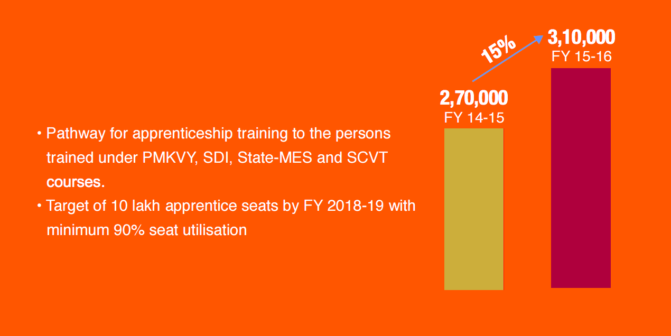National Apprenticeship Promotion Scheme
What is apprenticeship?
- An apprenticeship is a system of training a new generation of practitioners of a trade or profession with on-the-job training and often some accompanying study (classroom work and reading).
Why apprenticeship?
- Apprenticeship provides the much needed window to consolidate unorganised ways of working and aim for better matching of job aspirations with the outcome of skill development.
- Apprenticeship Training is considered to be one of the most efficient ways to develop skilled manpower for the country.
- It provides for an industry led, practice oriented, effective and efficient mode of formal training.
- The National Policy of Skill Development and Entrepreneurship, 2015 focuses on apprenticeship as one of the key components for creating skilled manpower in India.
- The policy proposes to work pro-actively with the industry including MSME to facilitate tenfold increase opportunities in the country by 2020.
- If implemented strategically, it may transform the unorganized or the informal sector through mutual benefits for the employer, the employee and the training organisations.
Government notifies National Apprenticeship Promotion Scheme
- Government has notified National Apprenticeship Promotion Scheme. It is for the first time a scheme has been notified to offer financial incentives to employers.
Details:
- The Scheme
- has an outlay of Rs. 10,000 crore
- with a target of 50 Lakh apprentices to be trained
- by 2019-20.
- 25% of the prescribed stipend payable to an apprentice would be reimbursed to the employers directly by the Government of India.
- The scheme also supports basic training, which is an essential component of apprenticeship training by sharing of basic training cost with basic training providers in respect of apprentices who come directly to apprenticeship without any formal trade training (fresher apprentices).
- All transactions including registration by employers, apprentices, registration of contract and payment to employers will be made as online mode.
- Eligible employers shall engage apprentices in a band of 2.5% to 10% of the total strength of the establishment.
- Employers need to register on the apprenticeship portal and must have TIN/TAN and any one of EPFO/ESIC/LIN.
- Brand Ambassadors will be appointed for states and for local industrial clusters to act as facilitators and promoters to promote apprenticeship training.
What are the possible issues that need to be dealt with?
- Traditionally, manufacturing industries have been successful in getting the best out of apprentices by giving them practical experience in the real working environment. For example, a qualified machine operator could not only gain workplace skills in addition to technical skills and rich knowledge, but enhance his market value by 3 times after completing the prescribed apprenticeship period.
- Even, if the person is not absorbed in the industry for some unavoidable reason, he or she could explore options for self-employment or entrepreneurship.
Let’s look at the seven ways to get started with successful implementation of National Apprenticeship Promotion Scheme (NAPS) in the unorganized sector.
1.The Micro, Small and Medium Enterprise (MSME) challenge
- Various micro, small and medium enterprises still work with unskilled or semi-skilled workforce. For them hiring trained people is not a priority as they are able to meet their needs without bearing the cost of trained people.
- But, they are not aware of how their output remains below quality and standards.
- It may be a challenge to convince them about taking apprentices on board; however with systematic education about long term benefits and incentives they can be brought into the fold.
2. Apprenticeship norms should be relaxed
- The legal aspect of Apprenticeship which could work against its larger acceptance are already being re-looked at. What we need is a friendly approach that benefits the industry, the training partners and the candidates to adopt apprenticeship models without the fear of tough labour laws, unnecessary paperwork and over-regulation.
3. Not limited to manufacturing sector
- The popular notion of apprentices being attached to the manufacturing sector limits its scope as a means for organised sector employment, particularly through the services industry. Today, we have apprentices working in customer service, sales, logistics and other sectors.
4. Apprentices are not cheap labour
- Even though the employers are not bound to pay them benefits like PF or ESI, there has to be a minimum stipend during the training period with access to facilities like accommodation, travel when needed.
5. Opportunity to leverage existing infrastructure
- Not all technical training institutions like ITIs or RVTIs can afford to purchase latest equipment, tools and technology. Apprenticeship helps skilled workers in upgrading their practical knowledge and being equipped with current industry standards.
6. Explore interoperability with quality frameworks
- Candidates who have qualified for various NSQF levels or acquired skills through the MES courses can shown a longer path for upskilling and employability. This will provide avenues for enhancing the scope of short term training through schemes like PMKVY to include flexible learn and earn options.

Source: Ministry of Skill Development and Entrepreneurship (MSDE)
7. Awareness and education among youth
- How do we make being an apprentice aspirational? Apprenticeships can be as powerful as internships, if promoted in the right way. It cannot be lihttp://nammakpsc.com/wp/wp-admin/post.php?post=5693&action=editmited to ITI or polytechnic students. Candidates from short term training programs like PMKVY or state skill development missions should be able to avail apprenticeship options for upskilling themselves
- We need to explore flexible and interoperable ways of integrating apprenticeship with existing training and skill development schemes. This is the best way enhance the value of skilled jobs and promote different paths to sustain the impact of skill based training among youth.











